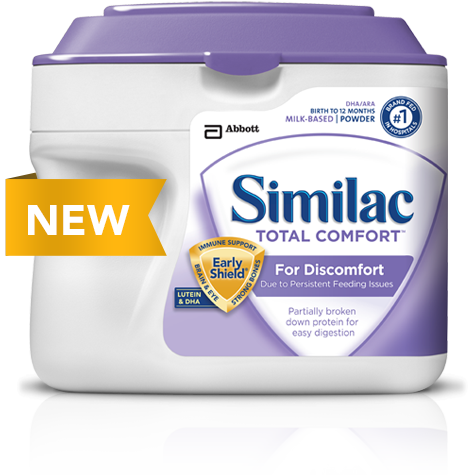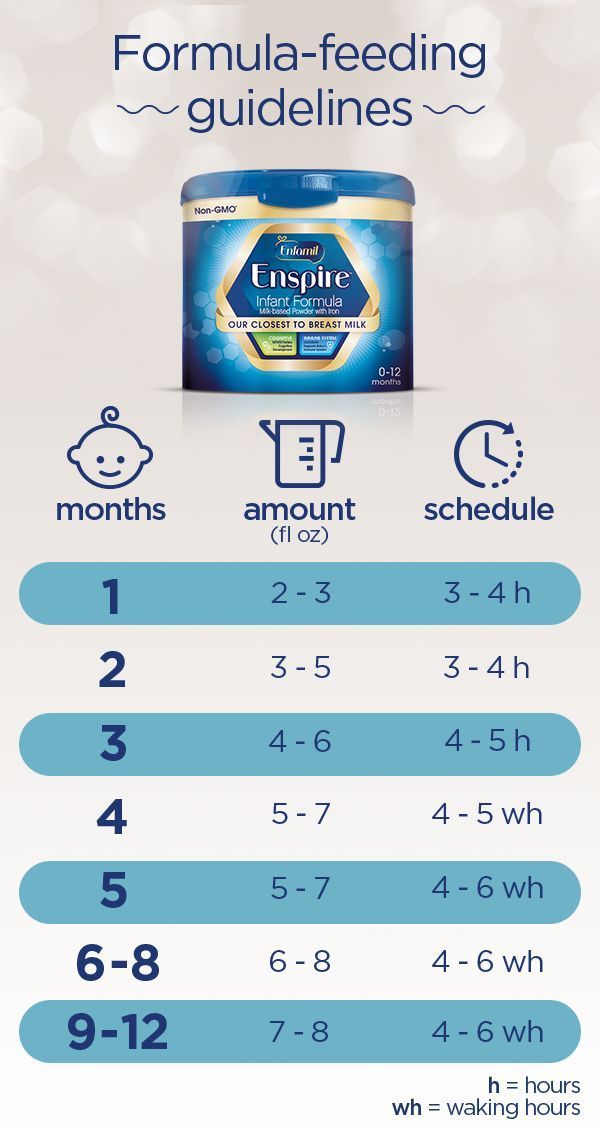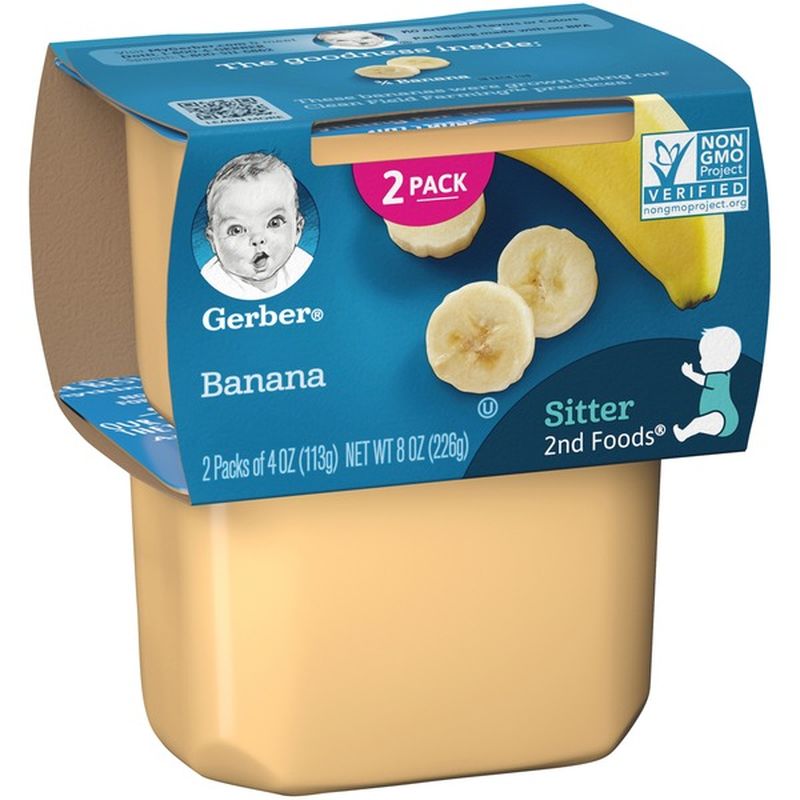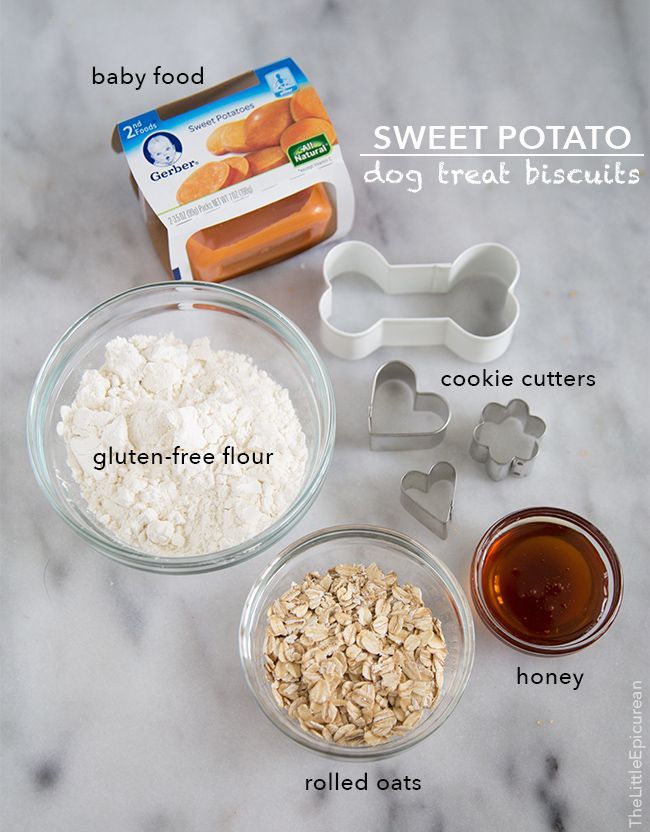Baby feeding chart similac
Growth and Nutrition Guide for Infant
How and why your baby’s diet should change throughout the first year
During your baby’s first year, you may have a lot on your mind. Imagine how your baby’s little brain must feel as it continues to grow! About 75% of its growth happens just during the first 12 months of life.
Vision that was blurry at birth will be clearer by 6 months. Your baby’s immune system, less than fully developed at birth, will continue to grow stronger as well. What supports these and other advancements? Proper nutrition, of course.
A varied and nutritious diet is essential for helping your baby to develop and stay healthy. But his nutrition needs will change as regularly as he does throughout his first year. By providing the following foods and nutrients in the suggested timeframes below, you can be confident your baby always has the nutrition needed to develop a strong mind and body during his eventful first year.
How much breast milk or formula is best for your baby?
*Daily Formula Feeding Averages
Age range |
Frequency/day |
Amount per feeding |
|---|---|---|
Birth to 1 week | 6-10 feedings | 2-3 fl oz each |
1 week to 1 month | 7-8 feedings | 2-4 fl oz each |
1 to 3 months | 5-6 feedings | 4-5 fl oz each |
3 to 6 months | 4-5 feedings | 6-7 fl oz each |
6 to 9 months | 3-4 feedings | 7-8 fl oz each |
9 to 12 months | 3 feedings | 7-8 fl oz each |
* This chart is based on bottle formula feeding only. Daily frequency and volume of feeding represent averages based on estimated caloric intake of babies 0 to 12 months.
Daily frequency and volume of feeding represent averages based on estimated caloric intake of babies 0 to 12 months.
If breastfeeding, your baby's intake and number of feedings might differ from the amounts shown in this table. If your baby usually breastfeeds for 10 minutes or more, but no longer than 60 minutes, they are likely getting enough breast milk. Let your baby, not the clock, determine how long feeding lasts.
The best way to feed your baby is to allow them to take as much time as they seem to need. If they're fussy and haven't been fed in more than 2 hours, it's probably time for a feeding.
For more information on formula feeding, see Formula Feeding 101
DID YOU KNOW?
- Breast milk or formula is the cornerstone of nutrition in your baby’s first year, providing vital nutrients, including protein, fat, calcium, vitamins, and minerals.
- Nutrients in breast milk or formula help your baby develop a strong immune system and support brain, muscle, bone, and organ growth.

- Similac® 360 Total Care® formulas have an exclusive blend of 5 of the most abundant HMO prebiotics found in breast milk. These formulas support baby’s whole-body growth and development, and have the closest prebiotic blend to that in breast milk. See our article on What’s in Formula.
- As your little one becomes a toddler, he can still get these immune-nourishing benefits. Go & Grow by Similac® NON-GMO¶ with 2’-FL HMO is the first toddler formula with this immune-nourishing prebiotic.
§ Not from human milk.
ǁ At significant levels.
¶ Ingredients not genetically engineered.
For more information on first-year nutrition for your little one, call the Similac® Feeding Expert at 800-986-8800.
What foods will your baby get introduced to in the first year?
Throughout their first year, you’ll be introducing new foods into your baby’s diet. Don’t introduce new foods all at once. It’s important to introduce new foods one at a time to identify any potential allergy. The information below can help you start new foods for your baby.
Don’t introduce new foods all at once. It’s important to introduce new foods one at a time to identify any potential allergy. The information below can help you start new foods for your baby.
For more info on this topic, check out our Food Allergies article here.
A varied diet helps your baby develop and stay healthy, but these needs change as he grows. By providing the following foods and nutrients in the timeframes listed, you'll be giving your baby the nutrition needed to develop a strong mind and body during the first year. For more information on providing the right first-year nutrition, call the Feeding Expert at 800-986-8800.
| Month 3 | Month 4 | Month 5 | Month 6 | Month 7 | Month 8 | Month 9 | Month 10 | Month 11 | Month 12 |
|---|---|---|---|---|---|---|---|---|---|---|
Cow’s milk- based foods |
| 1 serving | ||||||||
Grains & Cereals |
| 3-4 Tbsp or more | ||||||||
Vegetables |
| 1 Tbsp per meal, working up to 4-5 Tbsp per day | 4 Tbsp or more | 4-8 Tbsp | ||||||
Fruit |
| 1 Tbsp per meal, working up to 4-5 Tbsp per day | 4 Tbsp or more | 8-12 Tbsp | ||||||
Meat/Protein |
| 1 Tbsp | 2-4 Tbsp | |||||||
A note about cow’s milk-based foods
It’s important to note that cow’s milk itself should NOT be introduced to your baby’s diet until they reach 12 months of age. However, foods with milk-containing ingredients like cheese, yogurt, and butter may be introduced in month 10, assuming your little one has not been diagnosed with cow’s milk allergy (CMA).
However, foods with milk-containing ingredients like cheese, yogurt, and butter may be introduced in month 10, assuming your little one has not been diagnosed with cow’s milk allergy (CMA).
For more information, see our article on Cow’s Milk Allergy.
Cow’s milk-based foods are all about baby’s bones
No bones about it, cow’s milk-based foods can be important for helping your growing baby develop strong bones. These foods help support a baby’s bones by adding the bone-building nutrients calcium, phosphorus, and protein to his diet. Also important: Babies love these foods!
Good sources of single servings of cow’s milk-based foods include:
½ cup whole-milk yogurt
¾ oz cheese
If your baby has a diagnosed cow’s milk protein allergy, your doctor or dietitian will recommend appropriate formulas and foods to supply these nutrients.
What do grains and cereals bring to the party?
To help fuel activities such as rolling, crawling, and walking, grains and cereals give your little one the complex carbohydrates, vitamins (B complex), minerals (zinc and magnesium), and fiber they need.
Good sources of grains and cereals
- Iron-fortified baby cereals—start with single-grain cereals
- Finger foods like teething biscuits, pasta, puffs, and bread
At 8 to 12 months, give your little one foods that they can pick up to add texture and motivate finger dexterity.
The vital vitamins of veggies
The power of vegetables in your baby’s diet is mostly in the vitamins they deliver, such as:
- Vitamin A to support eyesight
- B vitamins to strengthen the immune and nervous systems and help with muscle and cell growth
- Vitamin C to help absorb iron
Stage 1 vegetables to try first
Mash up or blend veggies like:
- Peas
- Squash
- Sweet potato
At about 8 months, introduce cooked vegetable pieces the size of a child's thumbnail, with the consistency of canned cooked carrots.
Why are fruits important?
Besides tasting good to your baby, fruit provides vitamins and fiber important to their digestive well-being and overall health.
Stage 1 fruits to try first
Mash up or blend fruits like:
- Mango
- Banana
- Pumpkin
At about 8 months, introduce small amounts of protein the size of a child's thumbnail or smaller and the consistency of a baked apple.
What is protein’s superpower?
The protein found in meats (along with iron, B vitamins, and zinc) is a building block for muscle growth during your baby’s first year, and beyond.
Good sources of protein
- Cooked and pureed meats or poultry
- Cheese cubes
- Tofu
- Egg yolk
For a more in-depth look at starting your baby on solid foods, check out Starting Solid Foods.
Join MySimilac® Rewards for up to $400* in benefits and support throughout your journey.
* Offers may vary.
Sign Up
How Much, a Schedule & Safety Tips
Helpful tips for everything from choosing the right baby formula to determining the right formula amount
We understand that there are many reasons why you might decide to formula feed your baby. Maybe you need a trusted brand when choosing an infant formula.
Maybe you need a trusted brand when choosing an infant formula.
You’ll be happy to know that one big reason formula can be helpful is that It makes it easier to share feeding responsibilities with your partner or other family members. Whatever feeding options fit your lifestyle, we’re here to offer our support.
What’s in Similac
® formula?Our formulas are inspired by breast milk and designed to meet the nutrition needs of your baby and to support his growth and development. They provide important vitamins and minerals, and most have our exclusive blend of DHA, lutein, and vitamin E, to help give your little one a strong start.
Similac was the first leading infant formula brand with no artificial growth hormones.* It’s also the leading infant formula brand with no palm olein oil. This allows for greater absorption of nutrients like calcium, compared to formulas made with palm olein oil.1,2
To learn more, check out our What’s in Similac® formula? page.
Which formula is best for my baby?
While all infant formulas help to nourish your baby, there are many different types. Some are specially formulated to support specific nutrition needs your baby may have.
If you need help choosing a formula, talk to your doctor. You can also compare options with our Formula Finder.
The different types of baby formula
Milk-based, iron-fortified formula
This is the most common type of formula, and it’s often recommended by doctors. If this is your first time feeding with formula, it’s a good place to start. These formulas provide complete nutrition to support your baby’s growth and development. They contain milk-based protein and important vitamins and minerals, including iron. The carbohydrates in these formulas come from lactose, which is the major carbohydrate in breast milk.
Four milk-based formulas to try are Similac® 360 Total Care®, Pure Bliss™ by Similac, Similac® Organic and Similac® Organic with A2 Milk.
Mild-tolerance formula
- Sensitive infant formula
If your little one shows signs of a sensitive tummy, like fussiness, gas, or mild spit-up, sensitive formulas are designed to help. They contain carbohydrates such as maltodextrins, instead of lactose, making them suitable for infants who may be sensitive to lactose. Try Similac® 360 Total Care® Sensitive, a formula created for babies with sensitive tummies. - Partially hydrolyzed infant formula
If you’ve tried a sensitive formula and your baby is still showing signs of fussiness, gas, and mild spit-up, partially hydrolyzed formulas may help. This type of formula is also good for babies with lactose sensitivity. Similac Pro-Total Comfort™ has partially hydrolyzed whey protein and is great for babies who have difficulty tolerating other milk-based formulas. - Soy-based formula
If your baby has fussiness or gas when feeding with other formulas, you might want to try a soy-based formula. Soy-based formulas have been clinically shown to support growth and help reduce fussiness and gas. Your doctor may also recommend a soy formula if your baby has galactosemia. Vegan families often prefer a soy-based formula for their babies. No other soy-based formula has been studied more than Similac® Soy Isomil®. If your baby’s fussiness or gas seems excessive, ask your physician about switching.
Soy-based formulas have been clinically shown to support growth and help reduce fussiness and gas. Your doctor may also recommend a soy formula if your baby has galactosemia. Vegan families often prefer a soy-based formula for their babies. No other soy-based formula has been studied more than Similac® Soy Isomil®. If your baby’s fussiness or gas seems excessive, ask your physician about switching.
Specialized nutrition baby formula
If your baby has a food allergy or other specific nutrition needs, specialized nutrition formulas can help meet his needs.
For cow’s milk allergy, your baby’s doctor might recommend Similac® Alimentum®. It’s a hypoallergenic, extensively hydrolyzed formula for infants, including those with colic symptoms due to protein sensitivity and food allergies.3,4
To learn more about food allergies and the formula options, check out our Food Allergy and Colic section.
Similac® NeoSure® is specially designed for babies born prematurely to promote catch-up growth on the outside—and on the inside. It’s a nutrient-enriched formula that has increased protein, vitamins, and minerals compared to term infant formula.
For more information on nutrition for babies born prematurely, check out our Preemie section.
Organic baby formula
Organic formulas contain the same ingredients you would find in a standard, milk-based, iron-fortified formula. The difference is that all certified USDA-organic products must meet the USDA’s strict production and labeling standards. To bear the USDA organic seal, 95% of the ingredients must be organic and have no genetically modified ingredients. Learn more about Similac® Organic.
For more info on our organic formulas, visit our Organic & Non-GMO Formulas page.
Toddler drink
As your baby grows into a toddler and you start introducing new foods, picky eaters may miss out on some important nutrients. Toddler formulas, like Go & Grow by Similac® HMO, are designed for children between ages 12 and 36 months and can help fill nutrient gaps. Some of the nutrients toddlers may miss out on are iron, vitamin C, and vitamin E.
Toddler formulas, like Go & Grow by Similac® HMO, are designed for children between ages 12 and 36 months and can help fill nutrient gaps. Some of the nutrients toddlers may miss out on are iron, vitamin C, and vitamin E.
To learn more about the nutrition needs of your toddler, visit our Toddler section.
Baby formula preparation types
While there are different types of formulas, there are also differences in the ways formulas are prepared. Some provide convenience, while others are more economical.
Powder formula
When you think of baby formula, it’s probably the dry powder form. It comes in a canister, is measured with a scoop, and is mixed with water.
When not prepared, powder has a longer shelf life than ready-to-feed or concentrated liquid formula, which makes it a good option for those supplementing breast milk with formula.Ready-to-feed formula
This type of formula is convenient and ready to use, and it requires no water or mixing.
 Similac Ready to Feed is available in 2-fl-oz, 8-fl-oz, and quart-sized bottles. It’s great for traveling and on-the-go, anywhere.
Similac Ready to Feed is available in 2-fl-oz, 8-fl-oz, and quart-sized bottles. It’s great for traveling and on-the-go, anywhere.Concentrated liquid formula
A type of liquid formula that comes in a can and mixes easily with water—just add one part water to one part concentrate.
Once you’ve found a formula that’s the right fit for you, here are some great tips on How to Make a Bottle.
How do I know how much formula to feed and when to feed my newborn?
All babies are different when it comes to how often to feed—and the right feeding amount. That’s why it’s important to learn the cues your baby may give to signal hunger, like rooting for milk, making sucking movements, or putting his fingers to his mouth—even while sleeping. This will ensure that he’s getting the right amount of nutrition to support his health and development.
How to know if your baby is full
It’s helpful if you’re familiar with a feeding schedule that’s appropriate for your baby’s age. Your doctor can help with that. But your baby will let you know if he is full, so look for his signals. He might turn his head or stop sucking. Don’t think that you need to feed your baby an entire bottle.
Your doctor can help with that. But your baby will let you know if he is full, so look for his signals. He might turn his head or stop sucking. Don’t think that you need to feed your baby an entire bottle.
Feeding your baby too much can cause mild spit-up. That’s why it’s important to keep the following things in mind as you begin feeding:
- Know your baby's eating rhythm
- Follow your baby’s lead
- Feed when he naturally wants to eat
- Note that crying can be a late sign of hunger
Count the wet diapers
A general guide for whether your baby is getting enough food is the number of diapers you change each day. Six to eight wet diapers and 1 or 2 passed stools per day is an average.
Your baby's weight gain
You should notice your baby gaining a small amount of weight each week. But, because babies gain weight and develop at different rates, your doctor can tell you what’s normal for your little one.
If you notice any changes in your baby’s eating habits or digestion, make sure to talk to your doctor.
Is formula ever bad or unsafe for my baby?
You can feel confident about the fact that baby formula is among the most highly regulated food products. But here are a few guidelines to follow when buying, preparing, using, and storing it.
- Buying: Check that the product isn’t past the expiration date. Also make sure that the container isn’t damaged.
- Preparing: Be sure not to add too much water. This dilutes essential nutrients and can impact your baby’s nutrition. Once prepared, either feed or refrigerate the formula immediately.
- Using: If your baby is finished feeding from a bottle and doesn’t drink the rest within 1 hour, you should throw it away. After feeding, the formula contains bacteria from your baby’s saliva that can multiply. To help reduce waste, mix smaller portions and refill if necessary.
- Storing: Feed prepared powdered formulas within 24 hours after mixing if you’ve stored it in the fridge. And make sure to follow the storage instructions on the formula label.

Tips on how to formula feed a baby
Be loyal to one bottle brand
If you find a bottle brand that works for you, it helps to stick with it. That way you won’t need to search through mismatched nipples and rings when it’s feeding time. It also helps with neater storage!
Plan for on-the-go feeding
You won’t always be able to prep formula in the kitchen. Pack your baby bag with unopened bottled water, an empty feeding bottle, and premeasured scoop(s) of powdered formula. When it’s time to feed your little one, pour the appropriate amount of water into the feeding bottle, add the powder, shake, and serve.
Prep bigger batches
Instead of mixing just one bottle of formula every couple hours, save time by preparing a full pitcher in the morning. Keep the pitcher covered in the refrigerator and feed it throughout the day. Just make sure to toss anything that’s left the next morning, since prepared powdered formula is to be fed within 24 hours. Follow the label instructions for refrigeration details.
Follow the label instructions for refrigeration details.
Alternate feeding to get more sleep
What’s great about formula is that it makes it easier for mom to get help with feeding. Alternate nighttime feedings with your partner so both of you can get more sleep.
Skip the warming step
Some babies will only drink warm milk, but some babies aren’t quite as picky. If your baby doesn’t mind room-temperature bottles, you can use small, 2-fl-oz bottles of ready-to-feed formula and skip that step.
Invest in an electric bottle warmer
If skipping the warming step isn’t an option, consider buying an electric bottle warmer. You can also put your bottles underneath a warm tap or let them sit in a bowl of warm water to heat up. But, at 3 am, this tool will come in handy.
* No significant difference has been shown between milk derived from rbST-treated and non-rbST-treated cows.
References: 1. Nelson SE, et al. J Am Coll Nutr. 1998;17(4):327-332. 2. Koo WW, et al. Pediatrics. 2003;111(5, pt 1):1017-1023. 3. Sampson HA, et al. J Pediatr. 1991;118:520-525. 4. Borschel M, et al. Clin Transl Allergy. 2014;4(suppl 1):P95.
1998;17(4):327-332. 2. Koo WW, et al. Pediatrics. 2003;111(5, pt 1):1017-1023. 3. Sampson HA, et al. J Pediatr. 1991;118:520-525. 4. Borschel M, et al. Clin Transl Allergy. 2014;4(suppl 1):P95.
Join MySimilac® Rewards for up to $400* in benefits and support throughout your journey.
* Offers may vary.
Sign Up
How to properly introduce complementary foods to a child
#Food #For Mom #The introduction of complementary foods #0-6 months #6-9 months #9-12 months #12-18 months #18-24 months
The procedure and rules for the introduction of complementary foods, complementary foods for children.
Your baby is getting older, which means that his needs for energy and nutrients are also increasing. It's time to introduce complementary foods into your baby's diet. They not only give the baby the components necessary for development, but also help his digestive system prepare for the transition to full-fledged adult food. Here is another step on the road to independence.
It's time to introduce complementary foods into your baby's diet. They not only give the baby the components necessary for development, but also help his digestive system prepare for the transition to full-fledged adult food. Here is another step on the road to independence.
And best of all, the introduction of complementary foods is a new level of interaction between you and your baby. After all, you will have to experience a lot of new impressions and emotions together. What is worth only one satisfied look of the baby, who for the first time tried sweet fruit puree, or a cunning face smeared with porridge. And in order for these impressions to be only positive, complementary foods must be introduced carefully. So that the child's body can smoothly rebuild. To do this, we recommend that you follow a number of simple rules for the introduction of complementary foods.
- First, don't be too independent. Your pediatrician should help you determine if your baby is ready to start weaning and prepare a feeding schedule.

- You can introduce complementary foods only when your baby is completely healthy. Do not introduce new foods if the baby is sick or has been vaccinated. Wait 3-5 days. Also consider circumstances such as jet lag after a long flight, sudden temperature changes outside, and climate change. All this can have a negative impact on the adaptation of the child to a new product.
- Each type of complementary food is introduced separately with an interval of 3-5 days. In this case, it is very important to carefully observe the reaction of the child.
- To make it easier and faster to note a possible reaction to the introduction of the product, give it to the child in the morning.
- Remember that during the period of complementary feeding, mother's milk or infant formula remains the main food for the baby. Introduce your baby to new foods when he is hungry, so first let your baby try the new food (always with a spoon) and then breastfeed or an adapted formula.
 Remember the main rule of the introduction of complementary foods - its essence is that the baby gets acquainted with new products, and not to feed him enough with them.
Remember the main rule of the introduction of complementary foods - its essence is that the baby gets acquainted with new products, and not to feed him enough with them. - Caution must be exercised not only in the introduction of products in turn. It is necessary to monitor the size of portions of complementary foods that the baby receives. Start introducing each new product a little bit, from a quarter to one teaspoon, and gradually (in 5-7 days) increase to the desired volume. Be sure to observe how the baby reacts to the product.
- When you are just starting to introduce complementary foods, make sure that the consistency of the products is quite liquid and homogeneous, later, when the child's body gets used to, you can make the food thicker.
- Take your time! If the baby liked the zucchini puree, this does not mean that he can already try zucchini pancakes from your table.
- Cereals, vegetable purees, fruit juices and purees start with products containing only one ingredient.
 If the crumbs have an allergy, then you do not have to guess what it is.
If the crumbs have an allergy, then you do not have to guess what it is. - As the first vegetable dish, the baby is first given one-component purees from vegetables with delicate fiber (zucchini, pumpkin, cauliflower, broccoli). Vegetables with coarser fiber, such as potatoes, carrots and white cabbage, are introduced into the baby's diet later. The same applies to combined products of two or three vegetables.
- Grain based complementary foods, like any other, it is important to start with the safest foods. These are gluten-free and dairy-free cereals: rice, buckwheat and corn. They are recommended to be diluted with breast milk or milk formula that the child eats. Then the taste of porridge will be familiar to the child. Then you can gradually add dairy gluten-free cereals. And only then is it allowed to introduce cereals from gluten-containing cereals, such as wheat and oats, into the child's diet.
- Only after the successful introduction of vegetable purees and cereals can the baby be pleased with the introduction of fruit juices and purees into his diet.
 Do not complicate your life and do not give your baby fruit foods ahead of time. After all, having become acquainted with the sweet pleasant taste of fruits, a child may refuse to eat no less healthy, but not so tasty vegetable purees.
Do not complicate your life and do not give your baby fruit foods ahead of time. After all, having become acquainted with the sweet pleasant taste of fruits, a child may refuse to eat no less healthy, but not so tasty vegetable purees. - After six months, mashed meat is added to the diet of healthy babies. From seven months, egg yolk is added, and from eight months, children's cottage cheese. These products are the most important source of animal protein, which is so necessary for the growing body of a child.
- It is preferable to use industrial products for complementary foods. They are safe, enriched with vitamins and minerals. Their composition is always the same and does not depend on seasonality, which so affects the quality of products.
- Don't jump to conclusions that a child doesn't like a particular product. You should offer a new product at least 8-10 times with an interval of several days in order to understand that your baby does not like the food, and in some cases it takes up to 12-15 attempts.
 Be patient, and you and your baby will succeed!
Be patient, and you and your baby will succeed! - And of course, throughout the entire period of introducing complementary foods, do not forget to consult with your best assistant in matters of baby's health - the pediatrician. It's so important to make sure you're doing everything right.
The material was prepared on the basis of the “Program for optimizing the feeding of children in the first year of life in the Russian Federation”, Moscow: Union of Pediatricians of Russia, 2019.
The material is for informational purposes and cannot replace the advice of a specialist.
- SIMILAC-2300018
home
Useful articles
Complementary feeding rules
Why change infant formula after 6 months? Read the pediatrician's article.
— Olesya Vladimirovna, please tell us how the mixture that can be given from birth differs from the mixture that is given to children after 6 months.
— The mixture is a unique nutrition, because a huge number of scientists around the world are working on its creation. The composition of such food is carefully developed taking into account all the needs of the baby - I mean nutritional characteristics, as well as additional inclusions in the form of vitamins, trace elements and other useful components.
That is why we recommend giving preference not to a universal model, but to an age-appropriate mixture. Therefore, we advise you to follow simple logic - formulas 1, 2 and 3. Sometimes even a four occurs. And, believe me, it suits the child's body much more than whole milk.
- Why can't babies under 6 months of age be given formula that is intended for babies over 6 months old?
— The adaptive capabilities of the gastrointestinal tract of children in the first months of life and six-month-old children are different. At six months, the baby is already trying the first complementary foods and is ready to digest some adult food. The composition of the mixture is also changing, becoming "more mature" and suitable for children of this age.
The composition of the mixture is also changing, becoming "more mature" and suitable for children of this age.
— Why does a baby need to be switched to a new infant formula from 6 months of age?
- So that the child can receive nutrients, vitamins and trace elements in the proper amount.
- Is it necessary to change infant formula when the baby is 6 months old? What is fraught with refusal to switch to a new mixture, how will it affect the health of the baby?
- Often we all see a simple picture - the baby does not get enough. He starts acting up at the bottle as soon as the mixture runs out. It's just not enough for him. Mom begins to dilute more and more of the mixture to saturate the baby. But this is a burden on the stomach and intestines, they have to digest huge amounts of food. Why overload the gastrointestinal tract or make the child feel hungry?
— Does it matter if the child is fully formula-fed or mixed-fed? And in the first, and in the second case, the transition to a new mixture at 6 months is mandatory?
- I would recommend this transition in any case, regardless of whether the baby is artificial or receives both formula and mother's milk. Of course, in a situation with mixed feeding, this issue is less acute, but still deserves attention.
Of course, in a situation with mixed feeding, this issue is less acute, but still deserves attention.
How to transfer a child to a new formula
- Olesya Vladimirovna, we talked about changing the mixture by age. And what negative consequences can parents face who change infant formula too often for other reasons?
- Unfortunately, I often encounter such problems - parents themselves, uncontrollably, change one mixture after another in order to find, as they think, the optimal nutrition for the baby. In fact this tactic is quite dangerous . Each new dietary option is stressful and burdensome for the gastrointestinal tract. He will not have time to adapt, as again new introductory ones. And so several times. As a result - a seething tummy, regurgitation, problems with the stool.
The main conclusion is that it is not recommended to change the mixture frequently and, which is very important, abruptly. Only a smooth transition over a few days is acceptable.
- Do parents need to see a pediatrician before switching a child to a new formula? Do I need to take any tests?
- That would be ideal. The doctor will examine the child, ask the mother in detail, and possibly identify or suspect situations that require special nutrition. So, for example, children with lactase deficiency need a low-lactose or lactose-free mixture.
How to choose formula for 6 months
— A pediatrician should choose a new infant formula, but what should parents pay attention to when choosing a formula?
— For its composition. The absence of palm oil, the inclusion of additional useful elements, such as lutein for vision, nucleotides for immunity, omega acids for the nervous system and the brain, in particular.
Special attention deserves the basis - cow's and goat's milk. We can say with confidence that goat's milk is digested and absorbed better than cow's.
See also
- "How to choose the right formula"
Is it better to change the formula before or after the introduction of complementary foods? Why?
— I would recommend that you first establish formula nutrition, that is, change the first formula to the second, and then start introducing complementary foods. I'll explain why. The mixture will be the main food of the baby for a long time, even despite the introduction of vegetable, fruit puree and cereals. Therefore, first we create the base - adapted mixture 2 , the child gets used to it, and then we begin to introduce vegetables (or cereals for small children).
I'll explain why. The mixture will be the main food of the baby for a long time, even despite the introduction of vegetable, fruit puree and cereals. Therefore, first we create the base - adapted mixture 2 , the child gets used to it, and then we begin to introduce vegetables (or cereals for small children).
- Is it possible to transfer the child to a new mixture abruptly? How long does it take for a baby to switch to a new formula? What is fraught with too fast or slow translation?
— The new mixture, like complementary foods, is a completely unusual product for a child. How the baby's body perceives it largely depends on the correctness of its introduction. Therefore, abrupt changes in nutrition or the transition to a new mixture in 1-2 days are highly not recommended. The optimal period is a week.
Too slow - not dangerous, just meaningless. 6-7 days is the optimal time for a gradual decrease in the volume of the old food and an increase in the new one.
MAMACO ® 1 Premium with 2'-FL human milk oligosaccharides is an important step in the evolution of baby nutrition.
- What side effects can parents experience when switching to a new formula? What can be considered normal manifestations of dietary changes, and when should you see a doctor?
— If the child is introduced to a new diet gradually, then, as a rule, there are no side effects. The color or consistency of the stool may change slightly - this is normal. If, against the background of an unusual mixture, the stomach begins to boil, a rash, diarrhea or regurgitation appear - most likely, food is not suitable for the baby . In this case, you need to cancel it and seek advice and selection of a new mixture from a pediatrician.
— Is it true that when switching to MAMAKO 9 infant formula0167 ® Premium goat's milk has minimal side effects because goat's milk is hypoallergenic and great for babies?
— Yes, it is true. Goat milk is easier to digest, so this food is better perceived by the baby's gastrointestinal tract. It is not in vain that the mixture has the “Premium” mark, its composition is maximally adapted to the needs of the baby.
— What are the safest 6-month transition schemes?
— On the first day — 30 ml, watch and observe. There is no regurgitation, diarrhea, rash, bubbling belly - the next day we give more. And so on increasing, according to the scheme, which we have already talked about with you a little higher.
Adapted milk formula is not in vain bears such a name. It is indeed maximally adapted by scientists not only to mother's breast milk, but also to the age of the baby, and, consequently, to his needs. Therefore, it is very important that the child's nutrition changes as he grows and develops.











